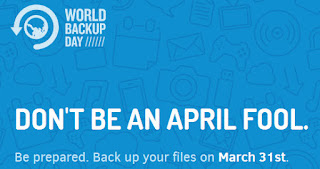World Backup Day on March 31 is supposed to be a reminder to take backup of one's data and not come out like a fool on April Fool's Day.
To help plan, here are six stages to consider this World Backup Day when building up your work process and utilizing your innovative muscles:
When backing up, make sure to likewise make in excess of one duplicate as this all gives an additional layer of security and configuration your utilized drives previously utilizing again as best practice and it will likewise give you consolation when passing the information between camera groups, altering groups and after creation groups.
 |
| Start backing up everything you create now if you haven’t already. Life happens, and you really don’t want something out of your control happening to all your personal digital property. |
How imperative is securely backing up all your computerized property—photographs, archives, recordings, money related records, programming, informal organization recognition, etc? Envision or imagine for a minute losing the greater part of that individual data to the wilds of nature following a catastrophic event, for example, a sea tempest, surge or tremor.
What might you do? You've spent a lifetime up to now settling on choices on an everyday premise on what messages, pictures, reports, notes, recordings and applications to keep; to what extent would it take to supplant the greater part of that property completely? In the event that you said another lifetime, that would be coherent.
However, you don’t have another lifetime to do this. Start backing up everything you create now if you haven’t already. Life happens, and you really don’t want something out of your control happening to all your personal digital property. Companies have disaster-recovery strategies; so should individuals.
Today, everything we do is converted to data. Lots of it. And with Seagate and IDC finding that by 2025, an average connected person anywhere in the world will interact with connected devices nearly 4,800 times per day — basically, one interaction every 18 seconds – the volume of data is only going to increase.
According to the organizers of World Backup Day, almost a third of us (30 percent) have never backed up our data. This is despite the fact that 113 phones are lost or stolen every minute throughout the world, and 1 in 10 computers are infected with viruses every month. The majority of this data loss (29 percent) is caused by accidents, such as losing a laptop or spilling liquid on the hard drive.
Whenever we suffer data loss, the results can be catastrophic. In the creative industries, what goes on behind the scenes of a film, photoshoot or video production is just as important as the finished product, if not more so. While creativity is the key factor, every creative professional will also talk about the importance of establishing a technical workflow that safeguards the content and allows any project to come together successfully.
We’re creating more data than ever before, with Seagate and IDC estimating that data creation in the wider world will swell to a total of 163 zettabytes (ZB) by 2025, ten times the amount we’re creating today. And for creative professionals, data use is growing too. Metadata and image tagging, multi-formatting for multi-platform use, and the ever-increasing quality of capture – like 4K and 8K, is bulking out file sizes. Due to these popular features, one piece of video content or a single photo in today’s world takes up far more capacity than it did 10 years ago.
To help plan, here are six stages to consider this World Backup Day when building up your work process and utilizing your innovative muscles:
1. Regular Backups
Since you have your work process and capacity design set up, you have to ensure it is taken after. Backing up a film as you shoot is a powerful, efficient approach to guarantee all substance is caught and remained careful. As said, a re-shoot can be an exorbitant exercise so getting into a propensity for doing regular backups is a smart thought.
When backing up, make sure to likewise make in excess of one duplicate as this all gives an additional layer of security and configuration your utilized drives previously utilizing again as best practice and it will likewise give you consolation when passing the information between camera groups, altering groups and after creation groups.
2. Archiving
Before you simply ahead and chronicle(archive), you should ensure that every one of your records are available. Your document structure will be valuable here, enabling you to watch that every one of the parts of the project are there – and working.
The projects utilized as a part of the innovative procedure, such as altering and evaluating programming, are always being updated, changed and adjusted. This can influence document to get to a test as individuals frequently chip away at various stages, forms and arrangements. It's vital accordingly that you archive your information in the most open route rather than discovering later that you can't get to a specific record.
3. Planning, Readiness, Arrangement
A work process should shape the establishment of any venture and an arrangement must be set up to figure out what you'll have to make it a win – including capacity. From content length, to shot determination, to document estimate, these must all be considered when settling on your capacity answer for abstaining from being left short toward the end.
Regardless of whether it be gear employ or the cost of an on-screen character's chance, numerous innovative ventures can't manage the cost of excessively numerous takes so securely moving down and putting away all documents is key. This all begins in pre-creation and expects you to think about only a single word, arrangement. How set you up are will eventually profit the last outcome.
4. Data Management
Everyone, in every walk of life, has their own way of doing things and this is particularly true in the creative industries. Once your footage has been shot and stored, the move into post-production is one that you want to keep as simple as possible in order to ensure the workflow is seamless.
A central part of that process is creating a consistent file structure that makes sorting and finding files as quick and easy as possible. This helps each team work together without any issues and create a better final piece of content.
5. Remaining Secure
And moving down your information, guarding it once it's put away is essential as well. Ensure you pick a dependable drive and set up some insurance. Regardless of whether it is a secret key or full encryption, choose what's appropriate for you and protect every one of your information.
There isn't a one-estimate fits-all approach for capacity and moving down, and there is no such thing as an immaculate work process or a failproof reinforcement. Be that as it may, the correct stockpiling arrangements, incorporated with a well-figured work process, can limit chances and guarantee that things don't get missed.
6. Do a Spring Clean
Have a look through your files and see what can be deleted. We often keep multiple versions of files for long periods of time, when in actual fact we no longer need to keep them because that particular project is now complete. During the editing phase, it’s also worth considering whether you still need to hold onto version one, when you’re now on the 100th edit. See what you can delete from your cloud storage, your hard drive or the images you have saved to social media.








No comments:
Post a Comment